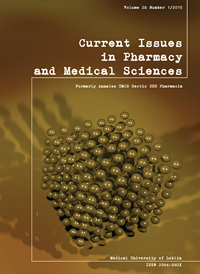A preliminary report on the susceptibility to aminoglycosides of Escherichia coli isolated from the community-acquired urinary tract infections in adults in south-east Poland
DOI:
https://doi.org/10.1515/cipms-2015-0037Keywords:
aminoglycosides, susceptibility, Escherichia coli, urinary tract infections (UTIs)Abstract
World-wide, urinary tract infections (UTIs) are an important clinical problem. In such, the most frequently isolated uropathogen is Escherichia coli. In the treatment of uncomplicated UTIs, e.g. cystitis, the widely used antibiotics are nitrofurantoin, trimethoprim/sulfamethoxazole, fosfomycin trometamol or ciprofloxacin, while the treatment of pyelonephritis requires the usage of antibiotics with a broader spectrum of activity, such as cephalosporins of the 3rd and 4th generation, aminoglycosides or even carbapenems. The aim of this study was to assess the susceptibility to aminoglycosides (such as amikacin, gentamicin, netilmicin and tobramycin) of E. coli isolated from UTIs in adult community patients living in Lubelszczyzna. We found that all of the 86 strains of E. coli encountered were susceptible to amikacin. Moreover, the prevalence of susceptibility to tobramycin, gentamicin or netilmicin among the tested strains was found to be 89,5%, 90,7% or 94,2%, respectively. The data obtained in the present study shows the high susceptibility to aminoglycosides of E. coli isolated from the community-acquired UTIS in adults. These data, together with that derived from current literature, indicate that aminoglycosides, when employed in combination therapy with other antibiotics, may still be very useful group of antibacterial agents in the treatment of UTI’s in Poland.
References
1. Alberici I. et al.: Pathogens causing urinary tract infections in infants: A European overview by the ESCAPE study group. Eur. J. Pediatr., 2014. [Web of Science]
2. Bien J. et al.: Role of uropathogenic Escherichia coli virulence factors in development of urinary tract infection and kidney damage. Int. J. Nephrol., 2012, Article ID 681473, 2012. doi: 10.1155/2012/681473 [CrossRef]
3. Firoozeh F. et al.: Detection of virulence genes in Escherichia coli isolated from patients with cystitis and pyelonephritis. Int. J. Infect. Dis., 219, 29, 2014. [CrossRef] [Web of Science]
4. Gupta K. et al.: International clinical practice guidelines for the treatment of acute uncomplicated cystitis and pyelonephritis in women: A 2010 update by the Infectious Diseases Society of America and the European Society for Microbiology and Infectious Diseases. Clin. Infect. Dis., e103, 52, 2011. [CrossRef] [Web of Science]
5. Hsueh P.R. et al.: Consensus review of the epidemiology and appropriate antimicrobial therapy of complicated urinary tract infections in Asia-Pacific region. J. Infect., 114, 63, 2011. [CrossRef]
6. Huang L.F. et al.: Antimicrobial susceptibility patterns among Escherichia coli urinary isolates from community-onset health care-associated urinary tract infection. J. Form. Med. Assoc., 970, 113, 2014. [CrossRef]
7. Ironmonger D. et al.: Surveillance of antibiotic susceptibility of urinary tract pathogens for a population of 5.6 million over 4 years J. Antimicrob. Chemother., 2015.
8. Jacskon J. et al.: Aminoglycosides: How should we use them in the 21st century? Curr. Opin. Infect. Dis., 516, 26, 2013. [CrossRef] [Web of Science]
9. Jafri S.A. et al.: Antibiotic resistance of E. coli isolates from urine samples of urinary tract infection (UTI) patients in Pakistan. Bioinformation, 419, 10, 2014. [CrossRef]
10. Lai B. et al.: In vitro susceptibility of Escherichia coli strains isolated from urine samples obtained in mainland China to fosfomycin trometamol and other antibiotics: A 9-year surveillance study (2004-2012). BMC Infect. Dis., 66, 14, 2014.
11. Leclercq R. et al.: EUCAST expert rules in antimicrobial susceptibility testing. Clin. Microbiol. Infect., 141, 19, 2013. [CrossRef]
12. Udo E.E., Dashti A.A.: Detection of genes encoding aminoglycoside modifying enzymes in Staphylococci by polymerase chain reaction and dot blot hybridization. Int. J. Antimicrob. Agents, 273, 13, 2000. [CrossRef]
13. Soleimani N. et al.: Frequency distribution of genes encoding aminoglycoside modifying enzymes in uropathogenic E. coli isolated from a Iranian hospital. BMC Res. Notes, 842, 7, 2014. [CrossRef]
14. Sorlozano A. et al.: Evolution of the resistance to antibiotics of bacteria involved in urinary tract infections: A 7-year surveillance study. Am. J. Infect. Control, 1033, 42, 2014. [CrossRef] [Web of Science]
15. www.eucast.org
Downloads
Published
Issue
Section
License
Copyright (c) 2015 Authors

This work is licensed under a Creative Commons Attribution-NonCommercial-NoDerivatives 3.0 Unported License.


